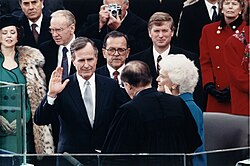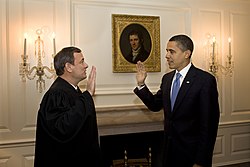| Date | Type | Event [b] | Location | Oath administered by |
|---|
April 30, 1789
(Thursday) | Public | First inauguration of George Washington | Balcony,
Federal Hall
New York, New York | Robert Livingston
Chancellor of New York |
March 4, 1793
(Monday) | Second inauguration of George Washington | Senate Chamber,
Congress Hall
Philadelphia, Pennsylvania | William Cushing
Associate Justice, U.S. Supreme Court |
March 4, 1797
(Saturday) | Inauguration of John Adams | House Chamber,
Congress Hall | Oliver Ellsworth
Chief Justice of the United States |
March 4, 1801
(Wednesday) | First inauguration of Thomas Jefferson | Senate Chamber,
U.S. Capitol
Washington, D.C. | John Marshall
Chief Justice of the United States |
March 4, 1805
(Monday) | Second inauguration of Thomas Jefferson | Senate Chamber,
U.S. Capitol |
March 4, 1809
(Saturday) | First inauguration of James Madison | House Chamber,
U.S. Capitol |
March 4, 1813
(Thursday) | Second inauguration of James Madison |
March 4, 1817
(Tuesday) | First inauguration of James Monroe | Front steps,
Old Brick Capitol |
March 5, 1821 [c]
(Monday) | Second inauguration of James Monroe | House Chamber,
U.S. Capitol |
March 4, 1825
(Friday) | Inauguration of John Quincy Adams |
March 4, 1829
(Wednesday) | First inauguration of Andrew Jackson | East Portico,
U.S. Capitol |
March 4, 1833
(Monday) | Second inauguration of Andrew Jackson | House Chamber,
U.S. Capitol |
March 4, 1837
(Saturday) | Inauguration of Martin Van Buren | East Portico,
U.S. Capitol | Roger B. Taney
Chief Justice of the United States |
March 4, 1841
(Thursday) | Inauguration of William Henry Harrison |
April 6, 1841 [d]
(Tuesday) | Private | Inauguration of John Tyler | Brown's Indian Queen Hotel,
Washington, D.C. | William Cranch
Chief Judge, U.S. Circuit Court of the District of Columbia |
March 4, 1845
(Tuesday) | Public | Inauguration of James K. Polk | East Portico,
U.S. Capitol | Roger B. Taney
Chief Justice |
March 5, 1849 [c]
(Monday) | Inauguration of Zachary Taylor |
July 10, 1850 [e]
(Wednesday) | Inauguration of Millard Fillmore | House Chamber,
U.S. Capitol | William Cranch
Circuit Court Judge |
March 4, 1853
(Friday) | Inauguration of Franklin Pierce | East Portico,
U.S. Capitol | Roger B. Taney
Chief Justice |
March 4, 1857
(Wednesday) | Inauguration of James Buchanan |
March 4, 1861
(Monday) | First inauguration of Abraham Lincoln |
March 4, 1865
(Saturday) | Second inauguration of Abraham Lincoln | Salmon P. Chase
Chief Justice of the United States |
April 15, 1865
(Saturday) | Private | Inauguration of Andrew Johnson | Kirkwood House Hotel,
Washington, D.C. |
March 4, 1869
(Thursday) | Public | First inauguration of Ulysses S. Grant | East Portico,
U.S. Capitol |
March 4, 1873
(Tuesday) | Second inauguration of Ulysses S. Grant |
March 3, 1877 [58] [c]
(Saturday) | Private | Inauguration of Rutherford B. Hayes | Red Room,
White House | Morrison Waite
Chief Justice of the United States |
March 5, 1877 [c]
(Monday) | Public | East Portico,
U.S. Capitol |
March 4, 1881
(Friday) | Inauguration of James A. Garfield |
September 20, 1881 [59] [f]
(Tuesday) | Private | Inauguration of Chester A. Arthur | Chester A. Arthur Home,
New York, New York | John R. Brady
Justice of the New York Supreme Court |
September 22, 1881 [f]
(Thursday) | Public | The Vice President's Room,
U.S. Capitol | Morrison Waite
Chief Justice |
March 4, 1885
(Wednesday) | First inauguration of Grover Cleveland | East Portico,
U.S. Capitol |
March 4, 1889
(Monday) | Inauguration of Benjamin Harrison | Melville Fuller
Chief Justice of the United States |
March 4, 1893
(Saturday) | Second inauguration of Grover Cleveland |
March 4, 1897
(Thursday) | First inauguration of William McKinley | Front of original Senate Wing
U.S. Capitol |
March 4, 1901
(Monday) | Second inauguration of William McKinley | East Portico,
U.S. Capitol |
September 14, 1901
(Saturday) | Private | First inauguration of Theodore Roosevelt | Ansley Wilcox Home,
Buffalo, New York | John R. Hazel
Judge, U.S. District Court for the Western District of New York |
March 4, 1905
(Saturday) | Public | Second inauguration of Theodore Roosevelt | East Portico,
U.S. Capitol | Melville Fuller
Chief Justice |
March 4, 1909
(Thursday) | Inauguration of William Howard Taft | Senate Chamber,
U.S. Capitol |
March 4, 1913
(Tuesday) | First inauguration of Woodrow Wilson | East Portico,
U.S. Capitol | Edward D. White
Chief Justice of the United States |
March 4, 1917 [60]
(Sunday) | Private | Second inauguration of Woodrow Wilson | The President's Room,
U.S. Capitol |
March 5, 1917 [c]
(Monday) | Public | East Portico,
U.S. Capitol |
March 4, 1921
(Friday) | Inauguration of Warren G. Harding |
August 3, 1923 [61] [g]
(Friday) | Private | First inauguration of Calvin Coolidge | Coolidge Homestead,
Plymouth Notch, Vermont | John Calvin Coolidge
Vermont Justice of the peace |
August 21, 1923 [61] [g]
(Tuesday) | Willard Hotel
Washington, D.C. | Adolph A. Hoehling Jr.
Judge, U.S. District Court for the District of Columbia |
March 4, 1925
(Wednesday) | Public | Second inauguration of Calvin Coolidge | East Portico,
U.S. Capitol | William H. Taft
Chief Justice of the United States |
March 4, 1929
(Monday) | Inauguration of Herbert Hoover |
March 4, 1933
(Saturday) | First inauguration of Franklin D. Roosevelt | Charles E. Hughes
Chief Justice of the United States |
January 20, 1937
(Wednesday) | Second inauguration of Franklin D. Roosevelt |
January 20, 1941
(Monday) | Third inauguration of Franklin D. Roosevelt |
January 20, 1945
(Saturday) | Fourth inauguration of Franklin D. Roosevelt | South Portico,
White House | Harlan F. Stone
Chief Justice of the United States |
April 12, 1945
(Thursday) | Private | First inauguration of Harry S. Truman | Cabinet Room,
White House |
January 20, 1949
(Thursday) | Public | Second inauguration of Harry S. Truman | East Portico,
U.S. Capitol | Fred M. Vinson
Chief Justice of the United States |
January 20, 1953
(Tuesday) | First inauguration of Dwight D. Eisenhower |
January 20, 1957
(Sunday) | Private | Second inauguration of Dwight D. Eisenhower | East Room,
White House | Earl Warren
Chief Justice of the United States |
January 21, 1957 [h]
(Monday) | Public | East Portico,
U.S. Capitol |
January 20, 1961
(Friday) | Inauguration of John F. Kennedy |
November 22, 1963
(Friday) | Private | First inauguration of Lyndon B. Johnson | Air Force One,
Dallas Love Field,
Dallas, Texas | Sarah T. Hughes
Judge, U.S. District Court for the Northern District of Texas |
January 20, 1965
(Wednesday) | Public | Second inauguration of Lyndon B. Johnson | East Portico,
U.S. Capitol | Earl Warren
Chief Justice |
January 20, 1969
(Monday) | First inauguration of Richard Nixon |
January 20, 1973
(Saturday) | Second inauguration of Richard Nixon | Warren Burger
Chief Justice of the United States |
August 9, 1974
(Friday) | Inauguration of Gerald Ford | East Room,
White House |
January 20, 1977
(Thursday) | Inauguration of Jimmy Carter | East Portico,
U.S. Capitol |
January 20, 1981
(Tuesday) | First inauguration of Ronald Reagan | West Front,
U.S. Capitol |
January 20, 1985
(Sunday) | Private | Second inauguration of Ronald Reagan | Entrance Hall,
White House |
January 21, 1985 [h]
(Monday) | Public | Rotunda,
U.S. Capitol |
January 20, 1989
(Friday) | Inauguration of George H. W. Bush | West Front,
U.S. Capitol | William Rehnquist
Chief Justice of the United States |
January 20, 1993
(Wednesday) | First inauguration of Bill Clinton |
January 20, 1997
(Monday) | Second inauguration of Bill Clinton |
January 20, 2001
(Saturday) | First inauguration of George W. Bush |
January 20, 2005
(Thursday) | Second inauguration of George W. Bush |
January 20, 2009
(Tuesday) | First inauguration of Barack Obama | John Roberts
Chief Justice of the United States |
January 21, 2009 [62] [i]
(Wednesday) | Private | Map Room,
White House |
January 20, 2013 [63]
(Sunday) | Second inauguration of Barack Obama | Blue Room,
White House |
January 21, 2013 [h]
(Monday) | Public | West Front,
U.S. Capitol |
January 20, 2017
(Friday) | First inauguration of Donald Trump |
January 20, 2021
(Wednesday) | Inauguration of Joe Biden |
January 20, 2025
(Monday) [j] | Second inauguration of Donald Trump | Rotunda,
U.S. Capitol |
| ZZZDate | ZZZType | ZZZEvent | ZZZLocation | ZZZOath administered by |
|---|
|





